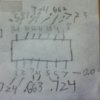- Joined
- Nov 28, 2011
- Messages
- 8,393
You may have forgotten the diode between pin 11 and the components that follow. If you add it, the circuit will work the way you want - kind of.
You may have forgotten the diode between pin 11 and the components that follow. If you add it, the circuit will work the way you want - kind of.
That circuit isn't going to do what you want. If the contacts drawn next to C1 are a touch switch, they won't do anything because that node in the circuit is driven by pin 11 of the IC. The behaviour you'll get is that when you touch the left hand contacts, the oscillator will run, and when you release them, it will stop. C1 will have no effect.
You can get the behaviour you want. I'll post a diagram shortly.

I checked the diode and the reading I got was .583! does that mean it is damaged?Right. If you have a diode between pin 11 and the rest of the circuit, then it will sort of work like an ON/OFF switch, with an undefined timeout. It will be slow to respond to the OFF contacts because the capacitor has to discharge through your finger resistance, and the timeout will be undefined. So you could say that it will work.
Your schematic in post #38 doesn't have that diode. It is there on the circuit board though:
View attachment 16044
If that diode is damaged, that would explain the problem you have. It could also be due to ESD damage to U1. So I agree with your electronics teacher.
You can try replacing the diode first because that's easiest. If you replace the 4011, put it in a socket. This should have been done originally. CMOS ICs are easy to damage, especially when you're soldering and unsoldering components that are connected to them.

